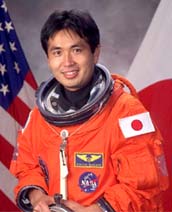 |
 |
On January 14, President George W. Bush announced a new vision for the United States human space development program and revealed a plan for human flights to the moon and to Mars. This challenge has re-energized the NASA Astronaut Office, which has had a difficult year since the Columbia accident. The safe restart of Shuttle flights and the completion of the ISS assembly are essential to make the plan for human missions to the moon and to Mars a reality.

While currently most of my work here has been devoted to the return to flight effort of the Space Shuttle, I am continuing my duties as a robotic arm instructor, my mission specialist training that includes the Space Shuttle and ISS systems, EVA, Russian language, and aircraft operations, as well as public relations activities both in Japan and the United States.
My Japanese astronaut colleague, Soichi Noguchi, will take part in the assembly of the ISS on the STS-114 mission, which is the next scheduled Shuttle flight. My goal is to contribute to the return to flight process so that his mission will be realized in the safest manner and as early as possible.
 KOICHI WAKATA KOICHI WAKATA
Astronaut, Manned Space Technology and Astronauts Department, Office of Space Flight and Operations
Born 1963, in Omiya, Saitama, Japan.
Koichi Wakata received a Bachelor of Science Degree in Aeronautical Engineering from Kyushu University in 1987 and a Master of Science Degree in Applied Mechanics from Kyushu University in 1989. He joined Japan Airlines (JAL) and was assigned to the Base Maintenance Department in Narita, as a structural engineer. From 1991 to1992, he worked in the Airframe Group of the Systems Engineering Office of JAL.
In April 1992, Wakata was selected as an astronaut candidate for the International Space Station assembly and operation flight by the National Space Development Agency of Japan (now part of JAXA, the Japan Aerospace Exploration Agency) and started training as a Shuttle Mission Specialist. He reported to the NASA Johnson Space Center in August 1992. There he completed one year of training and was qualified for assignment as a Mission Specialist on Space Shuttle flights.
In August 1993, after being certified as a Shuttle Mission Specialist, he continued advanced training in Shuttle system operations such as flight simulation, extra-vehicular activity, and robot-arm operations. As the first Japanese Mission Specialist, he flew on the STS-72 mission in January 1996. He also flew aboard the STS-92 mission in October 2000 and participated in the ISS assembly.
Currently, he belongs to the EVA and Robotics branches of the NASA Astronaut Office Robotics Branch and is involved in the development of technologies for return to flight of the Space Shuttle, while serving as a robotics instructor astronaut.
|
 |
4/4 |
 |
|
 |
 |